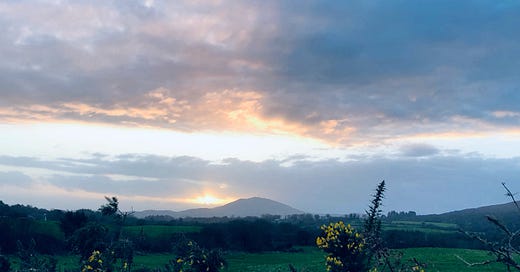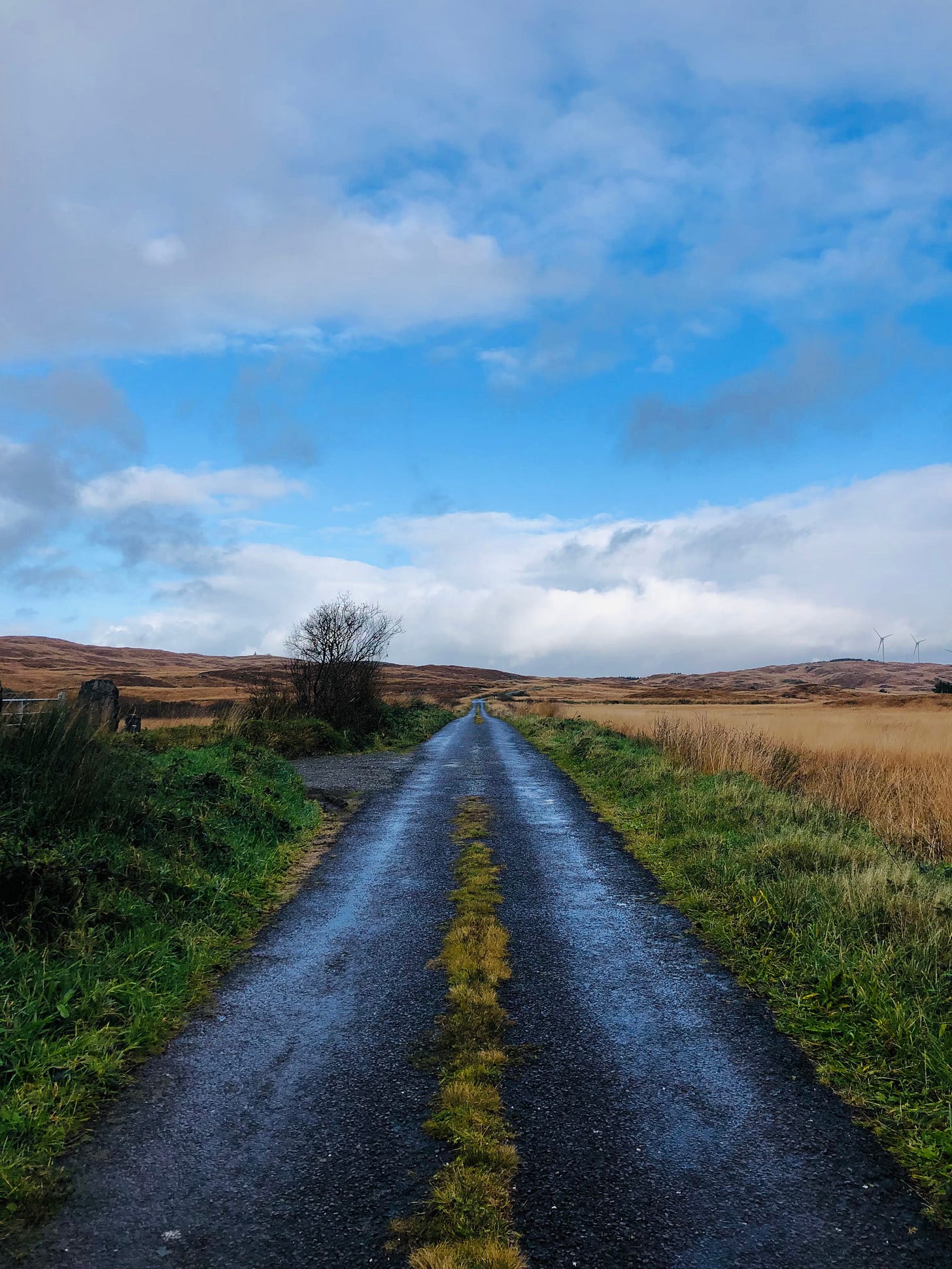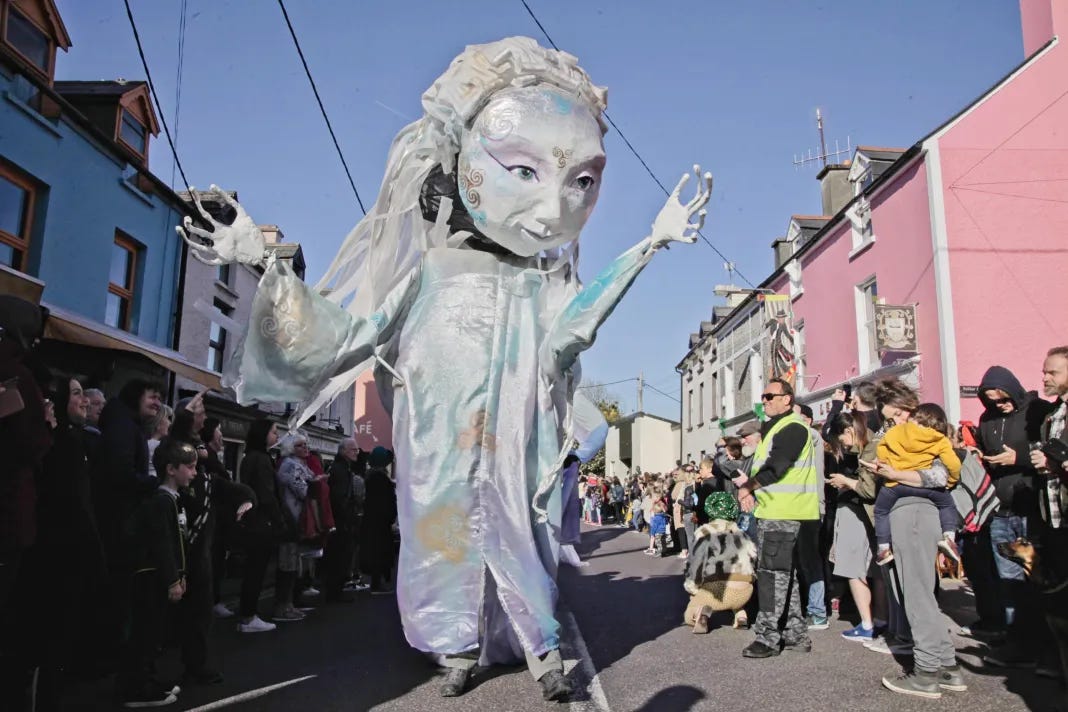Living In Ireland (Episode One) - It's A Small Place After All!
Ireland is a small country with a huge creative heart. A focus on culture brings people together and fosters a sense of community.
Moving to a new country is a big step. It is something that I know all about having lived in the UK, France, Spain, the USA and now Ireland! Alongside insights into the wonderful creative culture here in Ireland I want to share some occasional practical tips based on my experience here in West Cork. If you want to receive these posts first and support my work then it would be great to welcome you as either a paid or free subscriber to The JasonWard Creative Substack
This post is about a subject that often causes embarrassed giggles - size! In this case, however, it is about the size of a country and how that size can affect your experience of living here. Ireland is a small country but Irish culture is hugely influential all around the world. There is the writing of Brendan Behan, James Joyce, Oscar Wilde, Claire Keegan and Sally Rooney, the music of Van Morrison and U2 and even Michael Flatley and bloody Riverdance which, for wrong or right, provided a rocket powered acceleration to global interest in Irish culture. Recently it seems like there has been a resurgence in Irish creativity across theatre, movies and TV with Jessie Buckley winning Oliviers and BAFTAs, Cillian Murphy taking home a Golden Globe and the success of movies like The Banshees of Inisherin, Belfast and The Quiet Girl. But these successes continue a long line of creative endeavour. What appears different is an apparent greater openness and confidence in expressing a more authentic Irish cultural identity.
Whether it’s down to mass emigration, great writers or bloody Riverdance (again!), Irish culture has global recognition. This outsize cultural influence belies the physical size of the country. Ireland is six times smaller than Spain and about the same size as the US state of North Carolina which often surprises people coming here. When we were looking for a house in Ireland I was adamant that I didn’t want to be too far from Cork. Where I live now is just over an hour from the city and, if I went any further West I could commute to Newfoundland!
This proximity factor is a big advantage to living in a small country. I was talking to my neighbour last week about electric cars. When I mentioned range he said “Yes but how far can you actually drive in Ireland?” He is right. The distances between places tend to be short - although the bumps and potholes will slow you down! The drive from where I live in the far south west up to Dublin in the North East of the Republic is about 350km and another 100km to get to the border with the North - which is a touch more than the drive from Daytona Beach down to Miami. This means that you are never really far from anywhere.
A quick note about driving: Maximum speed limits are displayed in kmh (60mph = roughly 100kmh) and we drive on the left which is the same as the UK. There are many ‘fast’ roads with no overtaking permitted so if you are behind a slower driver, take a deep breath put the radio to Lyric FM and enjoy the countryside! You might also find some seemingly random speed limits on what are essentially country tracks. For example this road (photo below) has a speed limit of 80kmh / 50mph and it is a two way road so expect vehicles, horses and people coming in the opposite direction! But remember, as the road safety officer says, speed limits are not suggestions or objectives….on this road I am unlikely to exceed 20mph.
Being a small country also means that much has to brought in from abroad. The source for many goods was Britain, which was also a link in international delivery chains, but since Brexit, Ireland is pivoting much more towards the rest of Europe. Ferry routes to the UK have been replaced by services to France and Northern Spain. From an economic perspective Ireland does not have a large internal market due to its relatively small population of only 5 million people and although it has a healthy and positive trade balance, it produces goods that are not likely to be purchased by regular consumers . As the Central Statistics Office puts it:
“In Ireland we do not produce many avocados, cars or streaming television shows. Most of what we consume of these are imports. Avocados and cars are goods imports, and streaming TV is a service import.
On the other hand, we export a lot of meat, dairy produce, pharmaceuticals and IT services, since we produce more than we consume here”
Importing products can mean that you need to look harder to find things like brand name clothes that you might be used to getting easily in your own country. You could also find that next day delivery from your regular online retailers is no longer an option. But I am sure that is survivable!
You will, however, find wonderful produce. My home is in a very rural area and one of our local supermarkets, Supervalue, sells a ton of local produce including meats, cheeses, vegetables and fish all sourced within 20km or so from the store. There are also individual vendors in towns, at a myriad of markets and we even have an organic farmer selling roadside near us too. Prices are similar to the UK on most supermarket items except alcohol which is VERY expensive with your cheapest bottle of wine prices at around €8 ($8.75/£6.90). This is because nearly all wine is imported and because, within the EU, Ireland currently has the highest excise tax on wine, the second highest on beer and the third highest on spirits.
But if you can survive not being able to get the latest trainers on the day they drop, having to wait a couple of days for an Amazon delivery or drinking less wine, you will be rewarded by all the benefits that a small country has to offer.
Firstly there is a feeling of social connectedness. Obviously, if you live in a sparsely populated area then it not only feels like everybody knows each other but, actually, everybody does pretty much know each other! This makes it easy to find out useful information about suppliers (gas / wood / internet), but also it means that if you put in a little effort you will be rewarded with a ready made social network.
But even in the towns and smaller cities you will find a sense of shared community and familiarity. Much of this comes from the country not having a major metropolis - the population of the capital Dublin and its suburbs is only 1.5million compared to 3.8 million in Berlin and over 8 million in New York. Ireland’s second city, Cork, has a population of 222,526 which is half the size of Liverpool!
This level of social connectedness is reinforced in my area, and many others, by very strong cultural provision. In the village of 300 people near me, Ballydehob, there are three art galleries. a Michelin star restaurant and a live music venue that operates all year round. The galleries show local and national artists and the music venue, Levis’, features local performers together with Irish and international artists from musicians to poets. There are also several festivals throughout the year including jazz, traditional and country music. This provision is reflected across the region and country: pubs have live music nights and community arts centres present plays, have art exhibitions and host cultural events with other spaces offering dance, film and book readings.
Every year the Irish Arts Council and RTE, the national broadcaster, fund Culture Night / Oíche Chultúir. This is a nationwide celebration of culture and creativity that brings people together in virtually every city, town, village and neighbourhood in the country. There is support from live TV shows and sponsorship from private companies. The event is in its 19th year and in 2023 1,205,834 people engaged with 1,700 Culture Night events - this is around a quarter of the entire population! By supporting so many community initiatives and celebrating each group’s particular culture and creativity, Culture Night reinforces social cohesion and demonstrates the power of arts and culture to unite a population - which is a more straightforward task in a smaller country.
Investment in the arts in the Republic of Ireland is 4 times more per capita than in Northern Ireland. While more could always be done, this investment makes this small country an attractive place to live, it helps Ireland achieve a cultural dynamism and is fundamental in bringing Irish creativity and culture to the world.
Ireland may not make many cars but it knows how to make friends.
Thank you for reading my work. If you enjoyed it and would like more please consider becoming a paid or free subscriber. Thank you Jason
Footnote: As of January 2024 British citizens can live and work in Ireland with the same rights as Irish citizens thanks to the 1922 Common Travel Area. However, bringing your furniture, car and pets requires documentation and fees. If you are planning a move then check out https://www.citizensinformation.ie/en/ for more information.








This was so interesting Jason, thank you. I have only ever been to Dublin and this was very informative. You are clearly enjoying your new life there and with reason. That cheese looks divine!